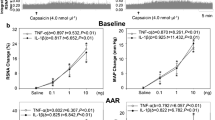Abstract
The regional sympathetic responses during fevers induced by an exogenous pyrogen, lipopolysaccharide, and by two endogenous pyrogens, interleukin-1 β (IL-1β) and tumor necrosis factor α (TNF-α), were compared in urethane-anesthetized rabbits. Rectal temperature (Tre), ear skin temperature (Tear) as an index for cutaneous sympathetic activity, renal sympathetic nerve activity (RSNA) representing visceral efferents, arterial blood pressure, and heart rate were recorded during fever caused by intravenous injections of each of the three pyrogens. Lipopolysaccharide (1 μg/kg i.v.) caused prolonged fever of more than 3 h duration with a tendency towards a biphasic course of temperature, whereas fevers induced by IL-1β (1 μg/kg i.v.) and TNF-α (10 μg/kg i.v.) were monophasic with a maximum between the 45th and 60th min. Each of the three pyrogens typically induced a decrease in Tear, indicative of cutaneous sympathetic activation, and simultaneous inhibition of RSNA during the first phase of rising Tre. RSNA tended to increase again approximately to its control level when the maximum Tre had been attained after the injection of each pyrogen. When the second rising phase of lipopolysaccharide fever started, Tear decreased once more, but RSNA remained at its control level. Taken together with the enhancement of IL-1 and TNF production during lipopolysaccharide-induced fever, the present results suggest the participation of these endogenous pyrogens in the responses of the sympathetic nervous system during the early phase of the lipopolysaccharide induced fever.
Similar content being viewed by others
References
Bernheim HA (1986) Is prostaglandin E2 involved in the pathogenesis of fever? Effects of interleukin-1 on the release of prostaglandins. Yale J Biol Med 59:151–158
Beutler BA, Milsark IW, Cerami A (1985) Cachectin/tumor necrosis factor: production, distribution, and metabolic fate in vivo. J Immunol 135:3972–3977
Dinarello CA (1983) Molecular mechanisms in endotoxin fever. Agents Actions 13:470–486
Dinarello CA, Cannon JG, Wolff SM, Bernheim HA, Beutler BA, Cerami A, Figari IS, Palladino MA Jr, O'Connor JV (1986) Tumor necrosis factor (cachectin) is an endogenous pyrogen and induces production of interleukin 1. J Exp Med 163:1433–1450
Dinarello CA, Cannon JG, Wolff SM (1988) New concepts on the pathogenesis of fever. Rev Infect Dis 10:168–189
Hales JRS, Iriki M, Tsuchiya K, Kozawa E (1978) Thermallyinduced cutaneous sympathetic activity related to blood flow through capillaries and arteriovenous anastomoses. Pflügers Arch 375:17–24
Hashimoto M, Nagai M, Iriki M (1985) Comparison of the action of prostaglandin with endotoxin on thermoregulatory response thresholds. Pflügers Arch 405:1–4
Hashimoto M, Bando T, Iriki M, Hashimoto K (1988) Effect of indomethacin on febrile response to recombinant human interleukin 1-α in rabbits. Am J Physiol 255:R527-R533
Iriki M, Hales JRS (1976) Spontaneous thermoregulatory oscillations in cutaneous efferent sympathetic activity. Experientia 32:879
Iriki M, Riedel W, Simon E (1971) Regional differentiation of sympathetic activity during hypothalamic heating and cooling in anesthetized rabbits. Pflügers Arch 328:320–331
Kikumoto Y, Hong YM, Nishida T, Nakai S, Masui Y, Hirai Y (1987) Purification and characterization of recombinant human interleukin-1β produced in Escherichia coli. Biochem Biophys Res Commun 147:315–321
Nagai M, Saigusa T, Shimada Y, Inagawa H, Oshima H, Iriki M (1988) Antibody to tumor necrosis factor (TNF) reduces endotoxin fever. Experientia 44:606–607
Nakamura H, Seto Y, Motoyoshi S, Kadokawa T, Sunahara N (1988) Recombinant human tumor necrosis factor causes longlasting and prostaglandin-mediated fever, with little tolerance, in rabbits. J Pharmacol Exp Ther 245:336–341
Old LJ (1987) Tumor necrosis factor: polypeptide mediator network. Nature 326:330–331
Riedel W, Iriki M, Simon E (1972) Regional differentiation of sympathetic activity during peripheral heating and cooling in anesthetized rabbits. Pflügers Arch 332:239–247
Riedel W, Kozawa E, Iriki M (1982) Renal and cutaneous vasomotor and respiratory rate adjustments to peripheral cold and warm stimuli and to bacterial endotoxin in conscious rabbits. J Auton Nerv Syst 5:177–194
Saigusa T, Iriki M (1988) Regional differentiation of sympathetic nerve activity during fever caused by intracerebroventricular injection of PGE2. Pflügers Arch 411:121–125
Schad H, Seller H (1977) A method for recording autonomic nerve activity in unanesthetized freely moving cats. Brain Res 370:51–57
Wolff SM, Mulholland JH, Ward SB (1965) Quantitative aspects of the pyrogenic responses of rabbits to endotoxin. J Lab Clin Med 65:268–276
Yamazaki S, Onishi E, Enami K, Natori K, Kohase M, Sakamoto H, Tanouchi M, Hayashi H (1986) Proposal of standardized methods and difference for assaying recombinant human tumor necrosis factor. Jpn J Med Sci Biol 39:105–118
Author information
Authors and Affiliations
Rights and permissions
About this article
Cite this article
Saigusa, T. Participation of interleukin-1 and tumor necrosis factor in the responses of the sympathetic nervous system during lipopolysaccharide-induced fever. Pflügers Arch 416, 225–229 (1990). https://doi.org/10.1007/BF00392057
Received:
Revised:
Accepted:
Issue Date:
DOI: https://doi.org/10.1007/BF00392057




